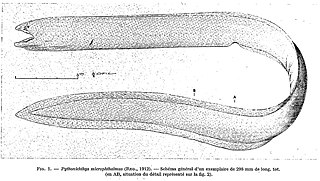
Gadiformes, also called the Anacanthini, are an order of ray-finned fish that include the cod, hakes, pollock, haddock, burbot, rocklings and moras, many of which are food fish of major commercial value. They are mostly marine fish found throughout the world and the vast majority are found in temperate or colder regions while a few species may enter brackish estuaries. Pacific tomcods, one of the two species that makes up the genus Microgadus, are able to enter freshwater, but there is no evidence that they breed there. Some populations of landlocked Atlantic tomcod on the other hand, complete their entire life cycle in freshwater. Yet only one species, the burbot, is a true freshwater fish.

The Congridae are the family of conger and garden eels. Congers are valuable and often large food fishes, while garden eels live in colonies, all protruding from the sea floor after the manner of plants in a garden. The family includes over 180 species in 32 genera.

The cusk-eel family, Ophidiidae, is a group of marine bony fishes in the Ophidiiformes order. The scientific name is from the Greek ophis meaning "snake", and refers to their eel-like appearance. True eels diverged from other ray-finned fish during the Jurassic, while cusk-eels are part of the Percomorpha clade, along with tuna, perch, seahorses and others.

The herring smelts or argentines are a family, Argentinidae, of marine smelts. They are similar in appearance to smelts but have much smaller mouths.

Paraulopus is the only genus in the family Paraulopidae, a family of grinners in the order Aulopiformes. They are commonly known as cucumberfishes, but locally some other Teleostei are also known by that name. They were considered in the Chlorophthalmidae or greeneye family until 2001.

Apateodus is a genus of prehistoric marine ray-finned fish which was described by Woodward in 1901. It was a relative of modern lizardfish and lancetfish in the order Aulopiformes, and one of a number of prominent nektonic aulopiforms of Cretaceous marine ecosystems.

Eels are ray-finned fish belonging to the order Anguilliformes, which consists of eight suborders, 20 families, 164 genera, and about 1000 species. Eels undergo considerable development from the early larval stage to the eventual adult stage and are usually predators.
Casierius is an extinct genus of marine ray-finned fish that lived during the Albian stage of the Early Cretaceous epoch. It was a relative of the modern bonefish in the extinct family Phyllodontidae, although some authorities consider it either a true albulid or a very early eel. It contains a single species, C. heckeli, known from the Glen Rose Formation near Hood County, Texas.
Ampheristus is an extinct genus of prehistoric marine ray-finned fish. It was a basal or stem member of the family Ophidiidae, which contains modern cusk-eels. Fossils are known from worldwide from the Late Cretaceous to the late Paleogene, making it a rather successful survivor of the Cretaceous-Paleogene extinction event.

The Argentiniformes is an order of marine ray-finned fish whose distinctness was recognized only fairly recently. In former times, they were included in the Osmeriformes as suborder Argentinoidei. That term refers only to the suborder of marine smelts and barreleyes in the classification used here, with the slickheads and allies being the Alepocephaloidei. These suborders were treated as superfamilies Argentinoidea and Alepocephaloidea, respectively, when the present group was still included in the Osmeriformes.

Pythonichthys is a genus of eels of the family Heterenchelyidae that occur in tropical waters of the eastern Pacific Ocean off of Panama and in the Atlantic Ocean near the Caribbean Sea and the west coast of Africa. It contains the following described species:

Argentina is a genus of fishes in the family Argentinidae.
This list of fossil fish species is a list of taxa of fish that have been described during the year 2012. The list only includes taxa at the level of genus or species.

The term Paleocene ammonites describes families or genera of Ammonoidea that may have survived the Cretaceous–Paleogene extinction event, which occurred 66.043 million years ago. Although almost all evidence indicated that ammonites did not survive past the K–Pg boundary, there is some scattered evidence that some ammonites lived for a short period of time during the Paleocene epoch, although none survived the Danian ; they were likely extinct within 500,000 years of the K-Pg extinction event, which correlates to roughly 65.5 Ma. The evidence for Paleocene ammonoids is rare and remains controversial.
This list of fossil fish research presented in 2021 is a list of new taxa of jawless vertebrates, placoderms, acanthodians, fossil cartilaginous fishes, bony fishes, and other fishes that were described during the year, as well as other significant discoveries and events related to paleoichthyology that occurred in 2021.

Eubaculites is an extinct genus of cephalopods in the family Baculitidae and each known species was initially placed within the related genus Baculites until it was placed in a separate genus in 1926.

The Rødvig Formation is a geological formation deposited during the earliest part of the Danian and it was first identified by Richard Taylor and Richard Phillips in 1827. It is known from exposures at Stevns Klint in Denmark. The unit lies directly above the K–Pg boundary and contains fossils that provide a record of the recovery of various groups following the Cretaceous–Paleogene extinction. The upper boundary of the formation is an unconformity in the form of a hardground, beneath which the formation is sometimes missing. The base of the unit is irregular due to the presence of mounding associated with bryozoa, causing variations in thickness. The unit is subdivided into the lower Fiskeler Member mainly formed of marl and the overlying Cerithium Limestone Member.
This list of fossil fish research presented in 2024 is a list of new taxa of jawless vertebrates, placoderms, acanthodians, fossil cartilaginous fishes, bony fishes, and other fishes that were described during the year, as well as other significant discoveries and events related to paleoichthyology that occurred in 2024.













